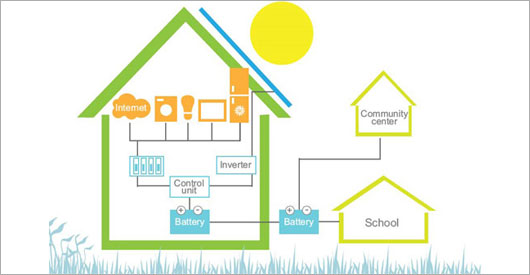Mozes and the EU Sensible Battery Project
Mozes has been successful in joining with the Universities of Nottingham, Seville, Oporto and Nurnberg as well as a group of European Technology Companies to win a funded research bid from the European Union.
The project ran from 2014 to mid-2018 and explored the potential for using energy storage technologies such as batteries within communities to reduce their fuel costs and overall energy use.
The project researched the storage of electricity produced by domestic photo-voltaic (PV) panels, using batteries. Batteries can be individual ones in each home – these store electricity produced by the home’s PV panels for use at peak times of electricity use during the day, and for times when the PV panels aren’t producing electricity. The project also researched the selling/sharing of electricity produced by individual homes between members of the community. It explored using ‘communal batteries’ as part of this, located in a local school and the library. It also looked at storing thermal energy (heat) produced by solar panels.
People within the Meadows who joined the project and had suitable houses and lifestyles were asked to host either battery technology, water heating technology and/or provide readings on their energy use. What each participating home was offered depended on whether the home had PV solar panels, whether it had a hot water tank, and other factors. At the end of the project the installed equipment was gifted to the participant. The aim was also for participants to be able to see how they were using their energy and how it would flow within the overall community.

There were two types of systems available as part of the SENSIBLE project. The first type was a system which converts PV energy into thermal energy using the ImmerSUN intelligent system which can divert excess energy and keep it within the home. The second type of system was a battery energy storage system, which diverts energy within the home, and is designed to level out peaks in energy use particularly in the morning and evening time.

The project involved the development of new technologies and new software. Storage of electricity, and other technologies, was set up in over 30 ‘test homes’ in the Meadows. Other ideas were simulated on computers because current regulations do not allow the sharing of energy across the local grid. There were energy use experiments within communities in the Meadows, Evora in Portugal and at the University of Nurnberg.
By using community battery banks it should be possible for generators within a community to share surplus energy with other community members and for both to benefit because the seller would get higher prices than they would get if they sold to ‘the grid’; but the buyers could be offered lower prices than those the energy companies retail at.
It is currently illegal to sell energy to each other in this country over public wiring, which is why some of this project was simulated but not actually carried out; but it is hoped that this project will show how effective it is in reducing the demand on the grid (therefore requiring less power stations) and reducing energy costs for individual householders.

Featured Partners








